
|
|
|
|
 |
|
Home Site Search Contact Us Subscribe
|
|
|
|
INSIGHT: The Cultural and Environmental Differences of Global Project Types
As the world's economy becomes more global, western developers, designers, and engineers must keep developing innovative ideas for efficiency improvement if they want to keep ahead. By Reg Monteyne, P.E., and Gary H. Pomerantz, P.E. September 5, 2007 As the world moves toward a global economy, developing countries are increasingly calling on the expertise of architects and engineers from the United States. The opening of China to foreign designers, starting the 1990s, is only one of the more recent and notable examples. At the same time, design firms continue to grow larger and open new branches in other countries, not to mention other parts of the U.S. For architecture and engineering firms, the challenge is to apply experience working in one country or region while responding to radically different cultures and climates. In our experience at Flack + Kurtz working on projects across the globe, the same building type looks and functions very differently in different places, despite serving similar purposes.
Climate Adaptations
Climactic variations have a significant effect on building design and engineering. In countries such as Thailand and Malaysia, for example, the climates are hot and humid year-round. As a result, buildings there require larger cooling and dehumidification equipment than in most areas of the West. In addition, the occupant density in Asian buildings is generally much higher than those in the U.S. – almost double the density in the case of airports and shopping malls. As a result, the air conditioning systems for these large projects must take into account the internal heat generated by so many people.
At the Suvarnabhumi (Bangkok) International Airport (in collaboration with Murphy/Jahn Architects, TAMS, ACT Consortium), the incoming outdoor air is sub-cooled to condense humidity from the air, and then released to comfort conditions using a heat recovery system. By contrast, in part of the San Jose Airport (in collaboration with Gensler), we are using evaporative cooling by adding humidity to the dry outside air.
Skyscrapers have their own challenges, given the high ratio of building skin to interior space. In New York, HVAC systems for skyscrapers generally have to be larger than those in tropical Asian countries, to contend with four distinct seasons. Heating systems have to be placed close to the windows, because the cold, windy weather of winter puts high demands on the building’s envelope. To keep cold drafts from entering occupied spaces, vestibules and revolving doors are common in New York skyscrapers. Climate also affects the choice of glazing. In New York City, expanses of clear glass make sense, especially for winter when days are short. In Kuala Lumpur, buildings endure 12 hours of sun every day all year long, so darkened glass is more practical to mitigate heat gain and reduce glare.
Even within the U.S., climates vary significantly enough to require very different solutions for the same building type. For the Mohegan Sun Casino expansion in Uncasville, Connecticut (Phase III with Wimberly Allison Tong & Goo/WATG), the HVAC system had to contend with four seasons and a riverfront site with high humidity in summer. In contrast, the new Fantasy Springs Casino in Indio, California (with RTKL), occupies the dry, hot desert where winter temperatures average in the 70s and summer daytime temperatures rise into the 100s. Fantasy Springs is busiest in the winter months, which are relatively cool when the “snowbirds” from the northern states and Canada swell the Palm Springs area population. Mohegan Sun, however, is busy year-round, pulling customers from Connecticut, New York, and Massachusetts. Coupled with the climate, the year-round occupancy results in much greater heating and cooling plant energy consumption than at Fantasy Springs.
Cost Considerations
In the U.S. and Europe, labor is relatively expensive, so the emphasis is on lowering construction costs by using advanced technical products. For example, the Hearst Tower in New York City (Foster + Partners/ Adamson Associates) makes use of an innovative “diagrid” frame that uses about 20% less steel than a conventional perimeter frame would. In Asian countries, however, labor is plentiful and less expensive. At the same time, while the materials for concrete are readily available in Asia, many other materials and products, such as large air conditioning chillers, high pressure pumps, and high performance glazing systems that are taken for granted in the U.S. and Europe, need to be imported. This translates into higher project costs. And even if designers specify the latest products from around the world, the contractors may not have the expertise to install them. The Petronas Towers in Kuala Lumpur (Pelli Clark Pelli, formerly Cesar Pelli & Associates) are a hybrid of concrete and steel. Because the Malaysian contractors were more familiar with concrete construction than with steel, concrete was used for the core walls and columns, while steel was used for the cladding. In China, concrete has been the most common choice for new office buildings, but some steel buildings are now beginning to rise. In Korea, most buildings have steel structures because the local steel industry is well developed.
In New York City, the choice of materials is driven more by availability, cost considerations, and union rules. Contrast this with Kuala Lumpur, where working seven days a week, and sometimes 24 hours a day, is typical and construction workers commonly live in purpose-built barracks at the construction site, resulting in shorter construction time.
Construction quality standards also vary. In China and Malaysia, the attention to detail is still generally not as high as in the more developed countries, and foreign designers who choose to work there often have to accept somewhat lower finish standards. In Japan, however, quality standards are higher than in the U.S. An example is the Apple flagship store in Tokyo (Bohlin Cywinski Jackson), a design-build project; the contractors paid a great deal of attention to choosing highest-quality equipment and mechanical systems. For Apple’s Manhattan flagship store (Bohlin Cywinski Jackson/Ronnette Riley Architect), the emphasis was more on cost-effectiveness, acknowledging that retail needs change so quickly that building for long-lasting durability wasn’t as important.
Citing cost concerns, developers in China and other Asian countries prefer to use locally manufactured equipment because of the high duties on some imports. As a result, many American, European, and Japanese companies are establishing joint ventures to manufacture products in China. For example, the Nanjing Jin Ao mixed-use skyscraper in Nanjing, China (Skidmore, Owings & Merrill/SOM), used locally manufactured under-floor air conditioning components; even two years ago such equipment could only have been obtained by importing it.
Code Challenges
The variety of different building codes can make working in other countries challenging for foreign architects. In China, the codes are written in Chinese and are often rigid. It’s more challenging to get an unusual systems design approved. The Super Brand Mall in Shanghai was designed as an eight-story complex. Chinese codes would have required fire shutters throughout to separate retail stores from the mall and divide the facility into compartments. Through fire modeling calculations, a performance-based smoke control system similar to what is allowed by American NPFA standards was ultimately approved.
In Thailand, because so many foreign consultants from different countries have brought their expertise to the country over the years, the authorities have borrowed from all of them to create codes that blend British, U.S., and Japanese standards. This sometimes results in conflicts between different aspects of the code, which the engineer or architect must resolve by presenting reasonable interpretations and reference project examples to the authorities. On the positive side, however, local authorities are more willing to consider professional advice than in the U.S., which has already well-established standards.
Historically, American firms have more experience in large, complex building projects than local firms in developing countries such as China and Malaysia. As a result, they tend to have more expertise in design, construction, fire safety, and advanced material selection. This is true for high-rise buildings and mixed-use projects. However, architects and engineers in those countries are quickly learning and adapting what took years to develop and implement in the United States. As the world’s economy becomes more global, western developers, designers, and engineers must keep developing innovative ideas for efficiency improvement if they want to keep ahead.
Reginald A. Monteyne, PE, LEED AP, Senior Vice President (San Francisco office) has more than 23 years experience at Flack + Kurtz, and over 30 years total experience in the design and management of virtually all project types, sizes, and complexities. He has been the principal mechanical systems designer and engineer of record on F+K’s most technically challenging projects. His current projects include Millennium Tower in San Francisco; residential towers LA Central and 700 Broadway in Los Angeles and San Diego, respectively; Lincoln Financial Field, the future home of the Indianapolis Colts; and MGM/Mirage City Center project in Las Vegas.
Gary Pomerantz, PE, LEED AP, Executive Vice President (New York office), has over 20 years experience in the design of heating, ventilation, and air conditioning systems. He has worked on a number of complex projects, in the United States and abroad, and has applied his expertise to a variety of project types including: academia, corporate, commercial, residential, sports facilities, and numerous broadcasting and cultural projects.
Founded in 1969, Flack + Kurtz, Inc. (F+K) provides complete services in mechanical, electrical, plumbing, and life safety systems design, in addition to offering sustainable design services and its own comprehensive information technology and communications, security systems design, and architectural lighting design. The firm has been rated consistently as one of the Top Five Building Services Engineers in the World by World Architecture Magazine since 1994. F+K is composed of a total staff of over 400 with offices in Las Vegas, San Francisco, New York, Seattle, Washington D.C., London, Paris, Hong Kong, and numerous other cities throughout the world through parent company WSP. |
(click on pictures to enlarge)  (Rainer Viertlböck) Suvarnabhumi (Bangkok) International Airport (Murphy/Jahn Architects/TAMS/ACT Consortium): incoming outdoor air is sub-cooled to condense humidity from the air, and then released to comfort conditions using a heat recovery system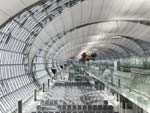 (Rainer Viertlböck) Bangkok International Airport interior (Gensler) San Jose International Airport North Concourse, California (Gensler), uses evaporative cooling by adding humidity to the dry outside air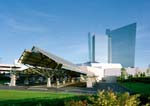 (WATG) Mohegan Sun Casino, Uncasville, Connecticut (Phase III: Wimberly Allison Tong & Goo/WATG): the HVAC system has to contend with four seasons and a riverfront site with high humidity in summer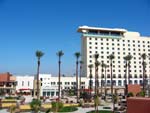 (RTKL) Fantasy Springs Casino, Indio, California (RTKL), is busiest in the cooler winter months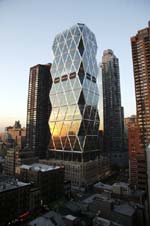 (Michael Ficeto/The Hearst Corporation) Hearst Tower, New York City (Foster + Partners/Adamson Associates): using advanced technology and materials (the “diagrid” frame uses about 20% less steel than a conventional perimeter frame) kept construction and labor costs within reason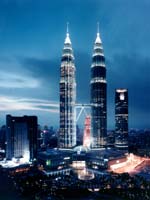 (Esto) Petronas Towers/Kuala Lumpur City Centre (Pelli Clark Pelli; formerly Cesar Pelli & Associates): concrete was for the core walls and columns and steel for the cladding because Malaysian contractors were more familiar with concrete construction than with steel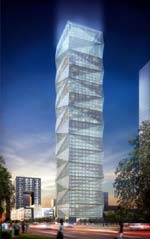 (SOM) JinAo Tower (a.k.a. Nanjing JinAo Complex), Nanjing, China (Skidmore, Owings & Merrill/SOM): the innovative design includes a double-skin façade and lateral bracing creates the 56-story tower’s faceted form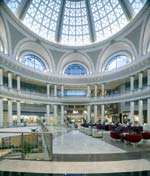 Westfield San Francisco Centre – 835 Market Street (KA Architecture; Kohn Pederson Fox/KPF; RTKL; Carey & Co.): One of the most challenging aspects of the project was restoring the historical dome Westfield San Francisco Centre – 835 Market Street (KA Architecture; Kohn Pederson Fox/KPF; RTKL; Carey & Co.): One of the most challenging aspects of the project was restoring the historical dome |
© 2007 ArchNewsNow.com